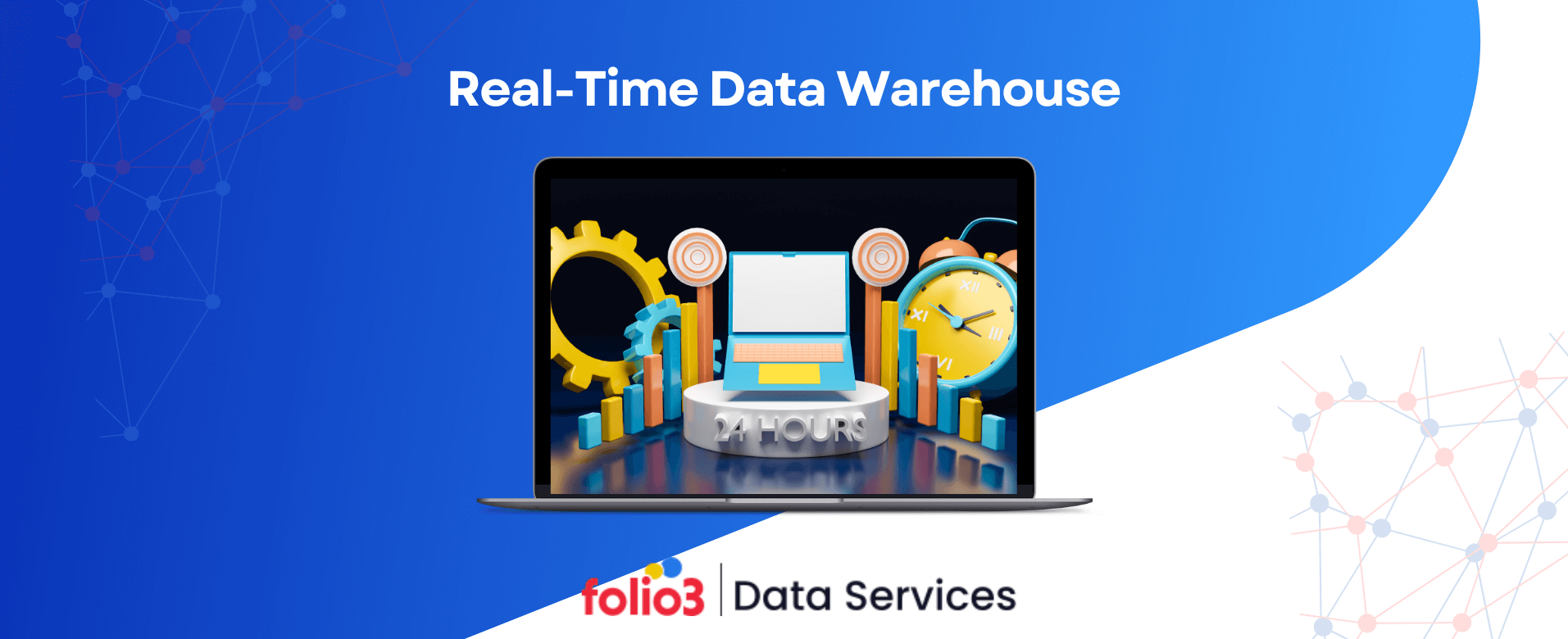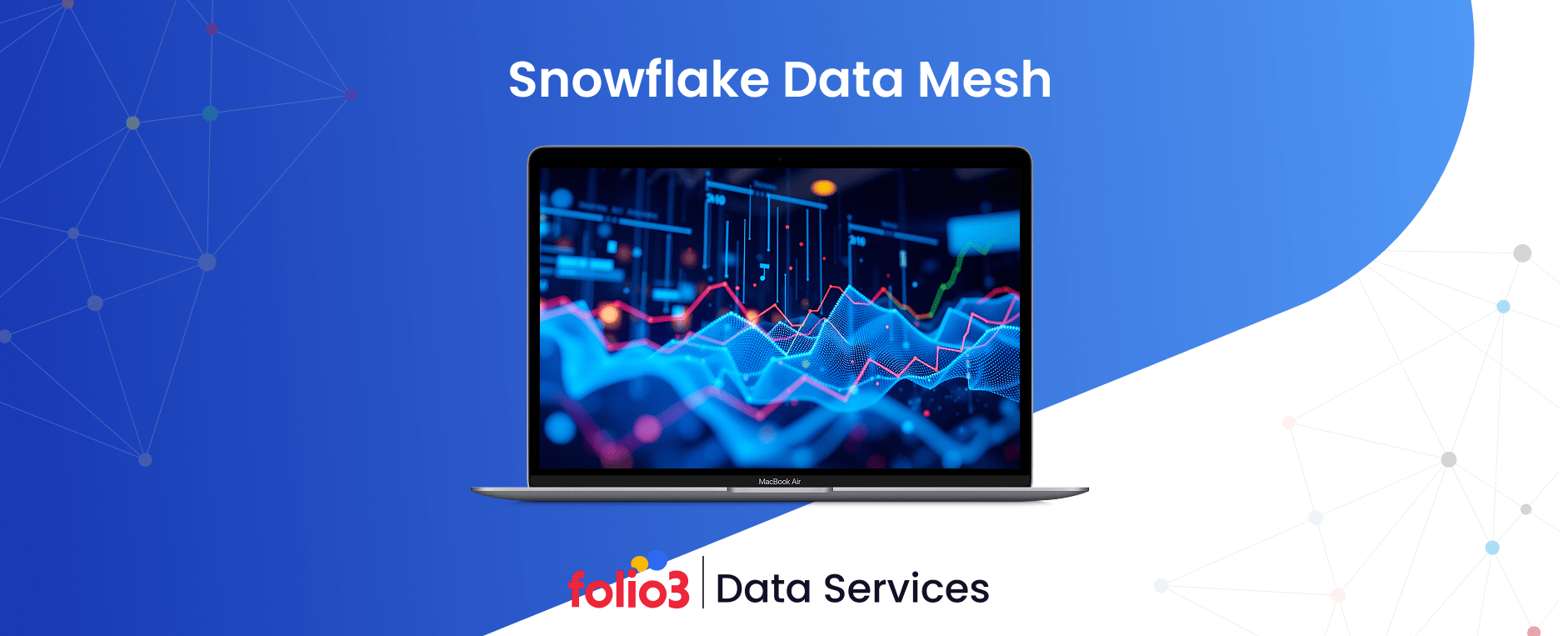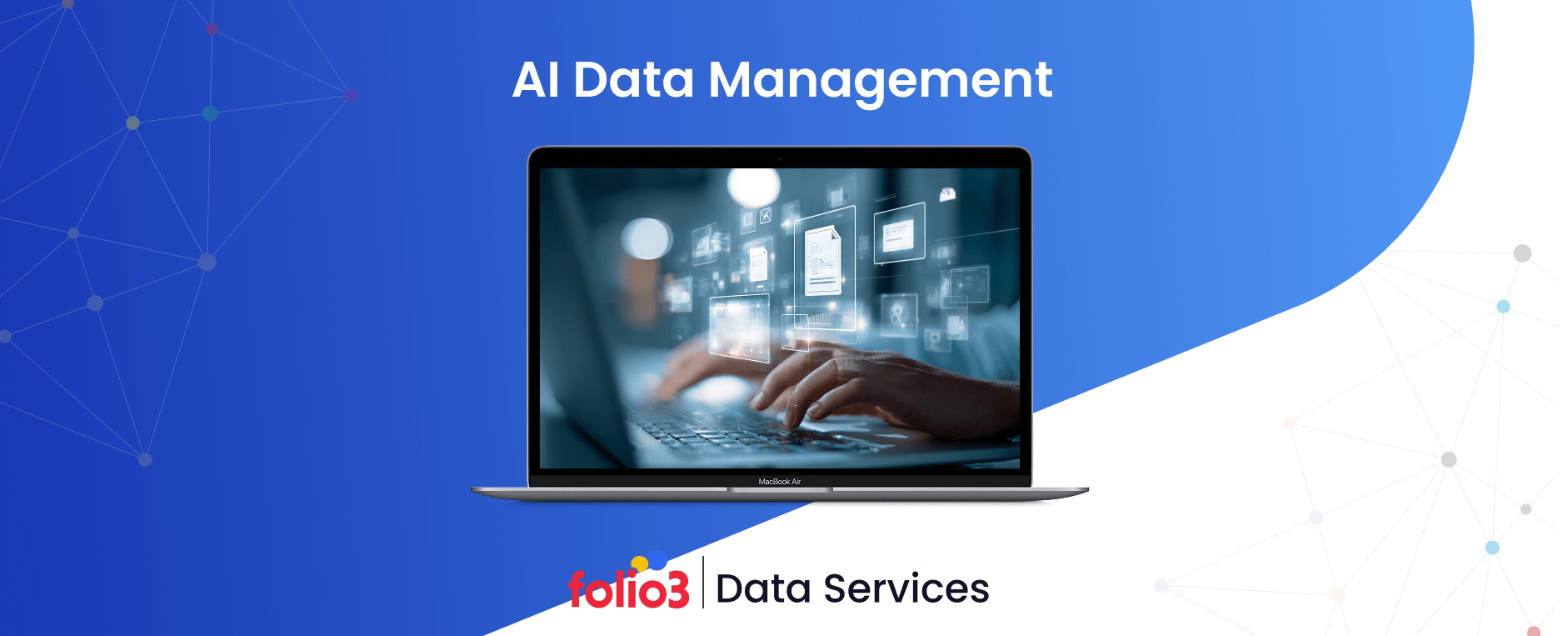Data-driven decisions are critical for success in staying in a top business environment. However, traditional data warehousing methods often need to improve to deliver the speed and flexibility that modern enterprises require. Real-time data warehouses offer a transformative solution, enabling businesses to access and analyze data as it is generated.
This article explores the concept of real-time data warehousing, its benefits, key features, implementation steps, challenges, and best practices to help you harness its potential for your organization.
What is a Real-Time Data Warehouse?
A real-time data warehouse is a specialized database architecture designed to collect, process, and analyze data with minimal delay. Unlike traditional warehouses that rely on batch processing, real-time data warehouses allow continuous data ingestion and instant query execution.
Integrating streaming platforms, advanced processing engines, and scalable storage, they support rapid decision-making and enable real-time insights, which are crucial for e-commerce, finance, and healthcare industries.
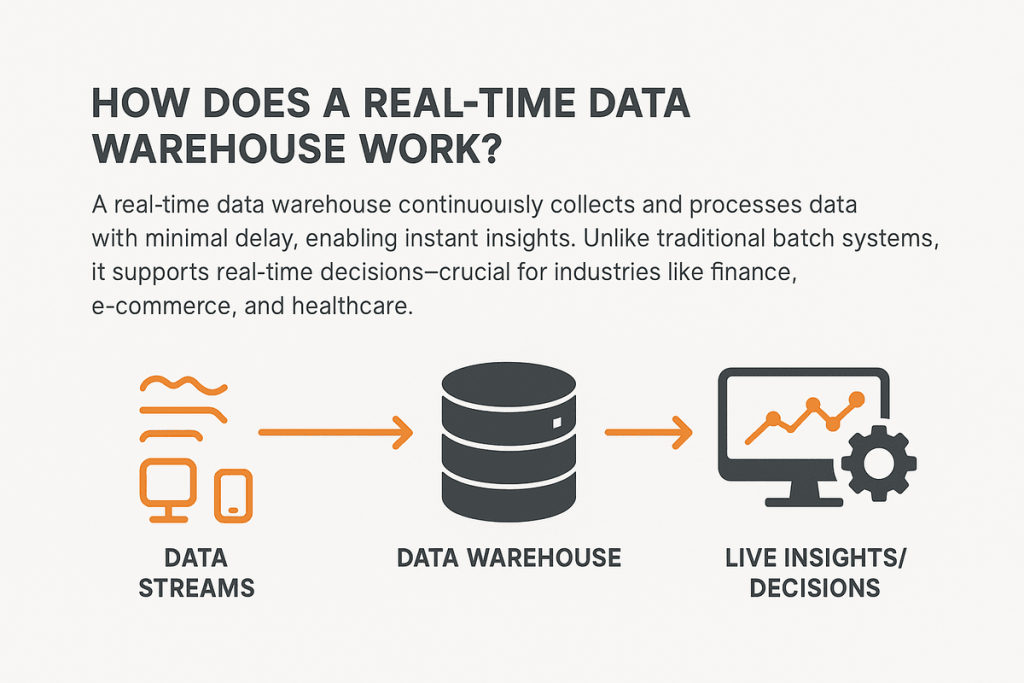
Benefits of Real-Time Data Access
Real-time data access is no longer a luxury but a necessity in today’s fast-paced, data-driven world. Businesses rely on instant access to accurate and actionable data to make timely decisions, respond to market dynamics, and stay ahead of the competition.
1. Faster Decision-Making
In competitive markets, timing is everything. With real-time data access, businesses can analyze information as it is generated, empowering decision-makers to respond to rapidly changing conditions. For example, retailers can monitor sales trends in real time and adjust pricing or inventory to meet demand fluctuations instantly.
Moreover, modern organizations often rely on database modernization to ensure their systems support the high-speed processing required for real-time analytics. By integrating data analytics consulting with data modernization tools, companies can eliminate bottlenecks, accelerate query performance, and make smarter, faster decisions to capitalize on emerging opportunities.
2. Enhanced Customer Experiences
Customers today expect highly personalized and seamless interactions. Real-time data insights enable businesses to instantly understand customer behavior and preferences, empowering them to tailor their services and marketing strategies dynamically.
Using this data, it can recommend products, offer timely discounts, or resolve issues proactively, significantly enhancing customer satisfaction and loyalty.
3. Improved Operational Efficiency
Operational efficiency is critical to maintaining profitability and staying competitive. Real-time data helps businesses monitor and optimize their operations continuously. From identifying inefficiencies in manufacturing processes to tracking logistics performance, real-time data provides actionable insights that enable companies to operate at peak efficiency.
For example, in supply chain management, data modernization tools can process live data from IoT sensors tracking shipments. This enables real-time visibility into potential delays or bottlenecks, allowing companies to adjust their logistics plans on the fly. Organizations can integrate real-time analytics into their workflows by adopting data modernization services and automating responses to challenges like equipment malfunctions or inventory shortages.
Key Features of a Real-Time Data Warehouse
Modern businesses demand data infrastructures that are agile, fast, and intelligent. A real-time data warehouse delivers these capabilities, allowing organizations to harness data as it is generated. The following key features are the backbone of a real-time data warehousing system:
1. Continuous Data Ingestion
Real-time data warehouses are designed to ingest data continuously from various sources, such as IoT devices, transactional systems, and application logs. Unlike traditional batch-processing systems, this uninterrupted data flow ensures that the latest information is always available for analysis.
This feature is essential for businesses that rely on up-to-the-minute insights to optimize their operations, from monitoring factory performance to analyzing live sales data.
2. Low-Latency Query Performance
One of the standout features of a real-time data warehouse is its ability to deliver insights with minimal delay. With low-latency query performance, businesses can execute complex queries on fresh data and instantly receive results.
This capability is crucial for applications like fraud detection, where real-time insights can prevent financial losses, or for customer service, where immediate data access enhances decision-making.
3. Scalability and Elasticity
Real-time data warehouses are engineered for scalability, enabling businesses to handle growing data volumes and increasing user demands without compromising performance.
These systems use horizontal scaling, allowing for the addition of resources as needed and ensuring the infrastructure remains agile in dynamic environments. Elasticity further ensures that resources are allocated efficiently, scaling up or down based on demand.
4. Integration with Streaming Platforms
Integration with real-time streaming platforms like Apache Kafka and AWS Kinesis, supported by data integration consulting, is a hallmark of modern real-time data warehousing systems.
These platforms facilitate the efficient ingestion, processing, and storage of streaming data, allowing businesses to react to live events.
For example, streaming platforms can process data from IoT sensors in agriculture, enabling farmers to monitor real-time soil conditions and weather changes.
5. Support for Complex Analytics and Machine Learning
Today’s real-time data warehouses are more than storage and query engines—they are complete ecosystems that support complex analytics and machine learning.
With built-in integration for tools like TensorFlow or PyTorch, businesses can perform predictive modeling and AI-driven decision-making directly within their data warehouses. This capability empowers organizations to derive deep insights, automate processes, and forecast trends, unlocking the full potential of their data.
Components of a Real-Time Data Pipeline
A real-time data pipeline ensures the seamless data flow from its source to actionable insights. Each component is critical in managing, processing, and delivering data for real-time decision-making. Below are the critical elements of a robust real-time data pipeline:
1. Data Sources
The pipeline starts with diverse data sources that generate real-time information. These sources are the foundation for creating meaningful, actionable data streams. These sources can include:
- IoT Sensors: For monitoring temperature, humidity, or machinery performance in industrial or agricultural settings.
- Transactional Systems: Capturing point-of-sale transactions or financial data.
- Social Media Feeds: Analyzing trends, customer sentiments, or marketing effectiveness.
- Application Logs: Tracking system events for performance monitoring or troubleshooting.
2. Streaming Ingestion
Real-time pipelines require mechanisms to ingest and process data continuously. The choice between ETL (Extract, Transform, Load) and ELT (Extract, Load, Transform) depends on the system’s requirements:
- ETL is used for on-the-fly data transformation before loading into storage.
- ELT loads raw data into the warehouse first, allowing for flexible post-processing.
Tools like Apache Kafka or AWS Kinesis are commonly used for high-throughput data ingestion.
3. Data Processing Engines
Data processing engines perform real-time transformations, enrichments, and computations on the ingested data. Popular engines include:
- Apache Flink: Ideal for stateful stream processing and handling complex computations.
- Apache Spark Streaming: Widely used for scalable, distributed data processing.
These engines enable immediate analysis, such as detecting anomalies in a production line or processing live video feeds for object recognition.
4. Storage Layers Optimized for Real-Time
Real-time workloads require low-latency storage solutions that support high-speed writes and instant reads. Popular storage systems include:
- Amazon Redshift: Known for its scalability and integration with AWS services.
- Google BigQuery: Offers serverless architecture for real-time querying at scale.
- Snowflake Consulting: Excels in handling both structured and semi-structured data with minimal latency.
These storage solutions ensure that data is readily available for real-time analytics.
5. Query and Reporting Tools
The final component of a real-time data pipeline involves query and reporting tools that visualize data and deliver actionable insights. Tools like:
- Tableau: Enables the creation of dynamic dashboards for real-time monitoring.
- Power BI: Offers interactive visualization and integration with various data sources.
These tools allow decision-makers to interact with live data through intuitive interfaces, ensuring they can respond swiftly to emerging trends or anomalies.
Real-Time Data Warehouse vs. Traditional Data Warehouse Comparison
| Aspect | Real-Time Data Warehouse | Traditional Data Warehouse |
|---|---|---|
| Data Ingestion | Continuous streaming from live sources | Periodic batch uploads (e.g., daily, weekly) |
| Latency | Low latency – near-instant data availability | High latency – delays from batch processing |
| Decision-Making Speed | Enables real-time or on-the-fly decision-making | Suitable for retrospective analysis and reporting |
| Use Cases | Fraud detection, real-time personalization, live inventory tracking | Monthly reporting, historical trend analysis, compliance audits |
| Data Freshness | Always up to date with current state | Based on last batch cycle; may lag behind by hours or days |
| Architecture | Stream-first; integrated with Kafka, Flink, Kinesis, etc. | ETL-centric; optimized for structured, batch-based data flows |
| Complex Analytics Support | Supports real-time ML/AI workflows and predictive modeling | Focused on BI reporting and historical dashboards |
| Scalability & Elasticity | Built to scale dynamically with cloud-native tools (e.g., Snowflake, BigQuery, Redshift) | Scaling often requires manual infrastructure provisioning |
| Cost Structure | Pay-as-you-go; optimized via cloud auto-scaling and serverless architectures | May require large up-front infrastructure and maintenance investment |
| Business Impact | Drives agility, proactive issue resolution, and improved customer experience | Supports long-term strategic planning and performance benchmarking |
Steps to Build a Real-Time Data Warehouse
Building a real-time data warehouse involves a strategic approach to integrate technology and streamline data workflows. Below are the detailed steps to create a reliable and efficient real-time data infrastructure:
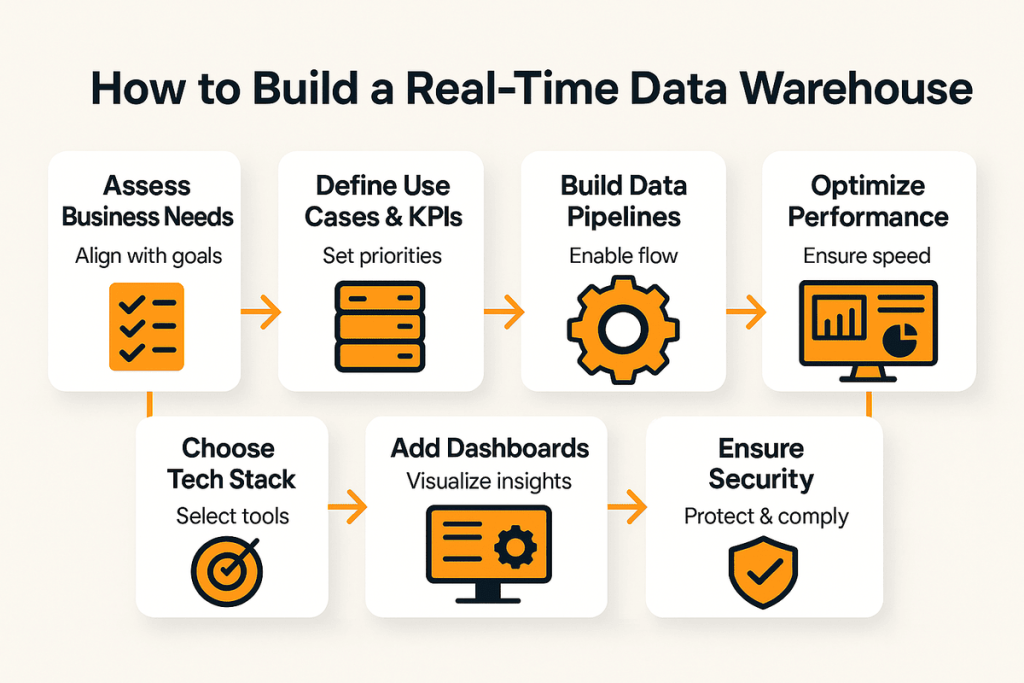
1. Assess Your Business Requirements
The first step is understanding what your organization needs from real-time data capabilities. This step ensures alignment between your data warehouse design and business objectives.:
- Identify specific goals, such as improving operational efficiency, enhancing customer experiences, or increasing fraud detection capabilities.
- Pinpoint challenges in current data systems, like latency issues or fragmented data sources.
2. Define Use Cases and Key Performance Indicators (KPIs)
A clear definition of use cases and KPIs will help determine the scope and priorities. Outlining these, businesses can focus resources on the most impactful areas:
- Use cases could include real-time inventory tracking, dynamic pricing adjustments, or supply chain monitoring.
- KPIs such as data ingestion speed, query response time, and system uptime provide measurable success benchmarks.
3. Choose the Right Technology Stack
Selecting the appropriate tools and technologies is crucial for a robust real-time data warehouse:
- Databases: Opt for systems like Amazon Redshift, Google BigQuery, or Snowflake that support low-latency queries.
- Streaming Tools: Use Apache Kafka, AWS Kinesis, or Azure Event Hubs for real-time data ingestion.
- Analytics Platforms: Use Tableau, Power BI, or Looker for real-time visualization.
Key Considerations
- Ensure compatibility with existing systems to reduce integration challenges.
- Focus on scalability to handle increasing data volumes and workloads.
- Verify tools support real-time ingestion and analytics processing.
4. Set Up Real-Time Data Pipelines
A well-designed pipeline architecture is essential for continuous data flow:
- Establish pipelines to ingest data from IoT devices, transactional systems, and logs.
- Implement ETL (Extract, Transform, Load) or ELT (Extract, Load, Transform) processes tailored for real-time operations.
Best Practices for ETL/ELT:
- Optimize transformation processes to reduce latency.
- Use parallel processing to handle high data volumes efficiently.
5. Optimize for Scalability and Performance
Performance optimization ensures the system remains reliable as data and user demands grow. These techniques help maintain low latency and provide seamless user experiences even under heavy loads:
- Implement partitioning to split large datasets into smaller, manageable chunks.
- Use indexing to speed up data retrieval.
- Integrate caching mechanisms to store frequently accessed data for quicker access.
6. Integrate Real-Time Dashboards and Analytics Tools
Enable data-driven decision-making through real-time visualization tools. Real-time dashboards ensure decision-makers have up-to-date insights to respond quickly to changing conditions:
- Provide stakeholders with intuitive dashboards using tools like Tableau or Power BI.
- Incorporate interactive features that allow users to explore data trends and drill into specific metrics.
7. Ensure Data Security and Compliance
Security is critical when dealing with real-time data. Robust security measures not only protect sensitive information but also build trust with stakeholders and customers:
- Employ encryption to secure data in transit and at rest.
- Establish role-based access controls to prevent unauthorized access.
- Ensure compliance with relevant regulations such as GDPR, HIPAA, or industry-specific standards.
Challenges in Implementing Real-Time Data Warehousing
Implementing a real-time data warehouse offers immense benefits, but it also comes with several challenges that organizations must address to ensure success. Addressing these challenges requires careful planning, robust technological solutions, and ongoing monitoring.
By tackling these issues head-on, businesses can unlock the full potential of real-time data warehousing. Below is a detailed exploration of these obstacles:
High Costs of Infrastructure
Maintaining and upgrading infrastructure costs can be prohibitive for small to medium-sized businesses, making cost optimization strategies critical. Real-time data warehousing requires significant investment in advanced technologies, such as:
- High-performance servers and storage solutions.
- Scalable cloud platforms like AWS, Google Cloud, or Azure.
- Specialized tools for real-time data ingestion and processing (e.g., Apache Kafka, Snowflake).
Partnering with providers offering data engineering solutions can help organizations design cost-effective architectures tailored to their scalability and performance needs.
Complexity in Data Integration
Combining data from diverse sources like IoT devices, transactional systems, and social media feeds poses integration challenges. Organizations need robust tools and expertise to handle this complexity effectively:
- Inconsistent data formats and structures require advanced transformation techniques.
- Legacy systems may lack compatibility with modern real-time platforms.
- Streaming vs. batch processing pipelines must be harmonized for seamless data flow.
Ensuring Low Latency at Scale
Maintaining low latency becomes increasingly difficult as data volumes grow. Real-time data warehouses must be designed with scalability and performance tuning to handle demand surges without compromising speed:
- High throughput systems can create bottlenecks in data processing.
- Query execution times may increase as datasets expand.
- Scaling horizontally requires sophisticated partitioning and indexing strategies.
Real-Time Data Quality and Consistency
Delivering reliable insights depends on consistent, high-quality data. Automated validation processes and continuous monitoring are essential to maintain data integrity:
- Real-time pipelines often ingest raw, unstructured data, increasing the risk of inaccuracies.
- Duplicate entries, missing values, or out-of-sequence events can compromise the validity of analytics.
- Ensuring data synchronization across systems is vital for accuracy.
Security and Compliance Considerations
Handling real-time data introduces heightened security risks and regulatory concerns. Failure to address these challenges can lead to significant financial and reputational risks:
- Sensitive information in transit or at rest is vulnerable to breaches.
- Organizations must comply with regulations like GDPR, HIPAA, or industry-specific mandates.
- Real-time data access requires stringent authentication and access control mechanisms.
Best Practices for Managing a Real-Time Data Warehouse
Managing a real-time data warehouse effectively requires strategic planning, robust technology, and ongoing optimization. Adhering to best practices ensures that the warehouse operates efficiently, delivers accurate insights, and adapts to evolving business needs.
Regularly Monitor and Optimize Pipelines
Continuous monitoring of data pipelines is critical to maintaining the reliability and performance of a real-time data warehouse. Since real-time systems handle continuous data streams, even small inefficiencies can compound over time, leading to latency or data inconsistencies.
Apache Airflow or AWS CloudWatch can help track data flow, identify bottlenecks, and ensure optimal performance. Regular audits and performance tuning, such as reconfiguring resource allocation or revising transformation logic, are essential to accommodate changing workloads and evolving data volumes.
Implement Automated Data Quality Checks
Maintaining data quality in a real-time environment is a constant challenge due to the high velocity and volume of data. Automated data validation and cleansing processes can help identify and resolve missing values, duplicates, or format inconsistencies before they impact downstream analytics.
Tools like Great Expectations or Talend can automate these checks, ensuring that only high-quality data enters the system. Setting up rules to flag anomalies, monitor thresholds, and validate data against predefined schemas ensures the accuracy and reliability of insights. Organizations can mitigate the risks of human error and focus on higher-level decision-making by automating these tasks.
Use Cloud-Native Services for Cost Efficiency
Cloud-native solutions, such as AWS Redshift, Google BigQuery, or Snowflake, provide the scalability and flexibility needed for real-time data warehousing while optimizing costs. These platforms offer pay-as-you-go pricing models, allowing businesses to align expenses with actual usage.
Features like auto-scaling and serverless computing enable organizations to handle spikes in data traffic without overprovisioning resources. Cloud-native tools simplify integration with real-time streaming services like AWS Kinesis or Apache Kafka, ensuring seamless data ingestion. Using cloud services reduces the need for on-premise infrastructure and associated maintenance costs, making real-time data warehousing accessible even to smaller organizations.
Use DevOps Practices for Continuous Deployment and Updates
Real-time data warehouses must evolve to meet changing business requirements and technology advancements. Leveraging DevOps consultancy ensures that updates to data pipelines, queries, and analytics tools are deployed seamlessly without disrupting operations, enabling businesses to stay agile and maintain uninterrupted access to critical data insights.
Continuous integration/continuous deployment (CI/CD) pipelines can automate testing, deployment, and rollback processes, minimizing downtime and reducing the risk of errors. Infrastructure-as-code (IaC) tools like Terraform can standardize and streamline resource setup, ensuring consistency across environments.
Real-Time Data Warehousing Summary
Real-time data warehousing enables organizations to access, process, and analyze data as it is generated, supporting instant insights, faster decision-making, and improved customer experiences. This blog explains what real-time data warehousing is, its benefits, key features, components of a real-time pipeline, and the differences from traditional warehouses. It also outlines implementation steps, major challenges, and best practices to help businesses build scalable, low-latency, and secure real-time analytics systems. By adopting real-time data warehousing, organizations can enhance operational efficiency, streamline workflows, and stay competitive in fast-moving markets.
FAQs
How is a real-time data warehouse different from a traditional one?
Traditional data warehouses process data in scheduled batches, causing delays in data availability. Real-time data warehouses, on the other hand, offer continuous data ingestion and low-latency querying, making them ideal for dynamic environments where timely insights are critical.
Which industries benefit most from real-time data warehousing?
Industries such as e-commerce, finance, healthcare, manufacturing, and logistics gain significant value. These sectors rely on up-to-the-minute data for activities like fraud detection, supply chain optimization, patient monitoring, and dynamic pricing.
What are the main benefits of real-time data warehousing?
Real-time data warehousing enables faster decision-making, improves operational efficiency, enhances customer experiences, and supports proactive issue resolution. With instant insights, businesses can react to trends, prevent disruptions, and optimize outcomes across functions like sales, support, logistics, and marketing.
How secure is real-time data warehousing?
Real-time data warehousing can be highly secure when best practices are followed, such as encrypting data at rest and in transit, applying role-based access control, and regularly auditing user activity. Compliance with standards like GDPR, HIPAA, or SOC 2 is also crucial for protecting sensitive data.
What are the performance metrics to monitor in a real-time data warehouse?
Key performance indicators (KPIs) include ingestion latency, query response time, data freshness, throughput (records/second), system uptime, and cost per query or per GB processed. Monitoring these ensures your system is fast, reliable, and cost-effective.
Conclusion
Real-time data warehousing has become a cornerstone for businesses seeking agility, precision, and competitive advantage. It transforms how organizations operate in dynamic markets by enabling immediate access to insights, optimizing operations, and driving innovation through advanced analytics. However, implementing and managing a real-time data warehouse requires expertise, tools, and robust strategies.
Folio3 Data offers comprehensive services tailored to your needs. From designing real-time pipelines to optimizing performance and ensuring data security, our solutions help you unlock the full potential of real-time data. Partner with Folio3 to modernize your data infrastructure and achieve unparalleled business efficiency.
